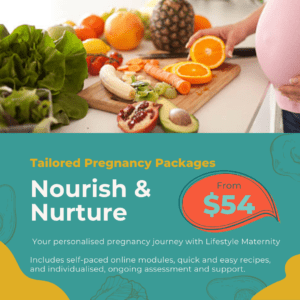Weight gain in pregnancy – it’s a hotly debated topic. Whether we post about it or discuss it with our antenatal colleagues we get some strong opinions and concerns.
“Yet another thing to feel guilty about while pregnant!”
“Is there any evidence that it makes a difference?”
“Setting a number for weight gain is just simply the wrong conversation!”
We agree!
Only focusing on a number, a simple target out of context, is not helpful and potentially even harmful.
Read on to see the history of weighing in pregnancy. We outline why it is important and how we are approaching best-practice care around healthy pregnancy weight gain for women at Lifestyle Maternity.
The history of weighing in pregnancy
Pregnancy weight gain advice has changed considerably over the years. This is because evidence has emerged about its links to the health of both a mother and her baby. The demographics of childbearing women has also changed (1).
- In the 1930s, all women were advised to gain 14 pounds (in metric that’s 6.3kg) to decrease the risk of pregnancy complications.
- In the 1970s, it was observed that increased pregnancy weight gain was associated with increased birth weight. It was surmised that pregnancy weight gain should not be restricted as it would likely be harmful with respect to birth weight.
- From the 1970s to 1990s, there was a move away from the ‘one size fits all approach’. And in 1990 the US Institute of Medicine released their pregnancy weight gain guidelines. These were developed primarily in response to concerns about low birth weight infants and, at the time, there was very limited data for women with high body mass indices (BMIs).
- Since then, overweight and obesity levels in childbearing women have increased dramatically. So too have complications associated with excess pregnancy weight gain. These include gestational diabetes, ‘large for gestational age’ babies and caesarean sections. Additionally, overweight levels amongst pre-schoolers have risen dramatically. These changes suggest excess weight gains are associated with negative maternal and infant outcomes. As a result the Institute of Medicine guidelines were revised to reflect optimal pregnancy weight gain for best outcomes for mothers AND infants.
Why do we focus on healthy weight gain in pregnancy?
Studies tell us that weight gain outside of the guidelines is linked with negative health consequences for both a mother and her baby. Pregnant women who gain weight in accordance with the US Institute of Medicine guidelines (adopted for use in Australia) have the lowest risk of pregnancy and birth-related complications.
These include both health and delivery complications. Women who gain weight above recommendations are more likely to have longer hospital stays, caesarean sections, high blood pressure and diabetes in pregnancy. They are also more likely to have trouble losing this weight after their baby is born and have difficulty breastfeeding. Women who do not gain enough weight are more likely to deliver their baby early.
What are the current pregnancy weight gain guidelines?
The amount of weight to gain in pregnancy differs based on a woman’s pre-pregnancy BMI. To work out your BMI divide your weight (in kilograms) by your height (in metres), squared. If you are using your calculator on your phone divide your weight by your height, and then divide it by your height again. Look in the table below to see the weight gain range for your BMI.
|
BMI (kg/m2)
|
Singleton (one baby) pregnancy total weight gain range (kg) |
Rates of weight gain in 2nd and 3rd trimester (kg/week) |
|
<18.5
|
12 ½ – 18 |
0.51 (0.44-0.58)
|
|
18.5-24.9
|
11 ½ – 16 |
0.42 (0.35-0.50) |
| 25-29.9 |
7 – 11 ½ |
0.28 (0.23-0.33)
|
| ≥30 |
5 – 9 |
0.22 (0.17-0.27)
|
We take a holistic approach to supporting healthy pregnancy weight gain at Lifestyle Maternity.
Weight is more than just a number …
Having a focus on the numbers on a scale (or in a table!) can be unhelpful. It doesn’t tell us the quality of what a mum is eating and nourishing her growing baby with. It doesn’t tell us how full or hungry she is. And it doesn’t tell us how active she is.
An obsessive focus on weight out of context can be stressful and cause anxiety – so that’s why we believe that monitoring weight is just one part of the puzzle with healthy pregnancy weight gain. As dietitians we also want to make sure that women are making healthy food choices, eating to appetite, and being physically active, and that baby is growing appropriately on scans. We also believe that we have a duty of care to support women in achieving these healthy lifestyle goals.
However, it is still important to track how a woman’s weight gain is progressing – to be able to make clinical decisions and to provide more support, when required. Just as action is taken when a blood pressure is shown to be high rather than just expecting it to change once it’s identified, we need to link the monitoring of weight gain to helpful ways to address it through dietary and lifestyle changes to ensure women have the healthiest pregnancies possible.
How do Lifestyle Maternity Dietitians talk about weight?
Societal stigma associated with obesity has relevance for all health professionals striving to maintain good patient relationships, whilst providing evidence-based care. Lifestyle Maternity Dietitians have undertaken a lot of work in this area to make sure they are supporting the women they see in the most caring and respectful way (2, 3, 4).
We have also been involved in training for our maternity colleagues who have told us that providing best-practice care is important to them, but they are scared of offending women and causing anxiety or blowing things out of proportion.
The research we have been looking into reminds us all that “words matter” and that terminology acceptable to women may differ from that routinely used by health professionals (5). We are learning from research that words such as ‘weight’ and ‘BMI’ are more likely to be positively received than references to ‘fat’ and/or (morbidly) ‘obese’ (6,7)(No surprises there!).
We support the approach that when we have conversations with pregnant women about healthy weight gain goals we avoid direct reference to BMI categories (e.g. ‘underweight’, ‘overweight’, ‘obese’ etc.). Simply stating “Based on your weight at the beginning of pregnancy, this weight gain is recommended for the healthiest pregnancy possible” is both respectfully and clinically appropriate.
Further to this, we also like to raise the important topic that food is neither good nor bad – it is morally neutral. Eating healthy food does not make someone good, just as eating less healthy food does not make someone bad. Rather than referring to food as good or bad, terms like every day and sometimes food are more appropriate.
What resources do Lifestyle Maternity Dietitians use to support healthy pregnancy weight gain?
We use a resource our Director and Principal Dietitian, Dr Shelley Wilkinson, developed during her PhD studies. This resource is called the Lifestyle Maternity Personalised Pregnancy Weight Tracker©. This evidence-based resource was developed to support healthy lifestyles during pregnancy. This easy-to-use tool takes the guess-work out of weight gain during pregnancy by allowing women to track their weight gain each week against international and Australian guidelines. All women who see the dietitians at Lifestyle Maternity will gain access to their BMI specific tracker in the Members’ section of our website.
Studies show that when a woman knows how much weight to gain during her pregnancy AND is provided with continual feedback about how she is progressing, she is more likely to gain an appropriate amount of weight.
Rather than a one-size-fits-all approach, this approach tailors a weight gain goal to each and every woman during her pregnancy.
Instructions provided with the Pregnancy Weight Tracker show how to start using the tracker. Watch our instructional video that accompanies the Tracker to help you complete it. Discuss it at each visit with us or any of your other health care providers.
References:
- Institute of Medicine. Weight gain during pregnancy: Reexamining the guidelines. 2009, Washington, D.C.: The National Academies Press.
- Wilkinson SA, Stapleton H. (2012). Overweight and obesity in pregnancy: the evidence-practice gap in staff knowledge, attitudes and practices. Aust N Z J Obstet Gynaecol. 52:588-592.
- Wilkinson, SA. Wilkinson, Shelley A., Poad, Di and Stapleton, Helen (2013) Maternal overweight and obesity: a survey of clinicians’ characteristics and attitudes, and their responses to their pregnant clients. BMC Pregnancy and Childbirth, 13 117: 1-8. doi:10.1186/1471-2393-13-117
- Wilkinson, Shelley A., Donaldson, Elin, Beckmann, Michael and Stapleton, Helen (2016) Service-wide management of healthy gestational weight gain following an implementation science approach. Maternal and Child Nutrition, 13 2: . doi:10.1111/mcn.12266
- Gray C, Hunt K, Lorimer K, Anderson A, Benzeval M, Wyke S. (2011). Words matter: a qualitative investigation of which weight status terms are acceptable and motivate weight loss when used by health professionals. BMC Public Health, 11(531). 29 June.
- Thomas S, Hyde J, Karunaratne A, Herbert D, Komesaroff P (2008). Being ‘fat’ in today’s world: a qualitative study of the lived experiences of people with obesity in Australia. Health Expect, 11:321–330.
- Wadden T, Didie E (2003). What’s in a name? Patients’ preferred terms for describing obesity. Obes Res, 11(9):1140–1145.
 Dr Shelley’s featured recipe on No Money, No Time.
Dr Shelley’s featured recipe on No Money, No Time.





 Find us on
Find us on